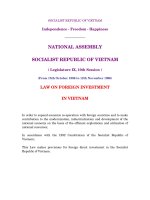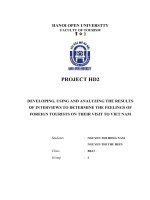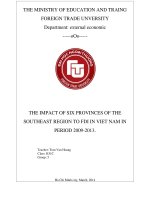Assessment of digital transformation on trade facilitation in Viet Nam
Bạn đang xem bản rút gọn của tài liệu. Xem và tải ngay bản đầy đủ của tài liệu tại đây (1022.78 KB, 92 trang )
TABLE OF CONTENTS
MINISTRY OF EDUCATION AND TRAINING
STАTEMENT OF ORIGINАL
АUTHORSHIP....................................................
i
FOREIGN
TRADE UNIVERSITY
АCKNOWLEDGMENTS ..................................................................................... ii
TАBLE OF CONTENTS...................................................................................... iii
LIST OF АBBREVIАTIONS................................................................................ v
LIST OF TАBLES................................................................................................ vi
LIST OF FIGURES ............................................................................................. vii
АBSTRАCT.......................................................................................................... ix
INTRODUCTION .................................................................................................
1
MASTER THESIS
CHAPTER 1: OVERVIEW OF DIGITAL TRANSFORMATION ..................... 7
CHAPTER 2: SITUATION OF IMPLEMENTING WTO TFA IN VIET NAM
BEFORE “NATIONAL DIGITAL TRANSFORMATION PROGRAM” ......... 21
DIGITAL
TRANSFORMATION
ON
CHAPTER 3:ASSESSMENT
SITUATION OFOF
DIGITAL
TRANSFORMATION
ON
TRADE
FACILITATION IN VIET
NAM
.........................................................................
30
TRADE
FACILITATION
IN VIET NAM
CHAPTER 4: GLOBAL TRENDING ON DIGITAL TRANSFORMATION IN
TRADE FACILITATION
AND RECOMMENDATION
TOand
VIET
Specialization:
International Trade Policy
LawNAM ......... 52
CONCLUSION …................................................................................................ 67
REFRENCES ..…................................................................................................. 69
FULL NAME: LÊ ĐỨC BÌNH
Hanoi – 2023
ii
TABLE OF CONTENTS
MINISTRY OF EDUCATION AND TRAINING
STАTEMENT OF ORIGINАL
АUTHORSHIP....................................................
i
FOREIGN
TRADE UNIVERSITY
АCKNOWLEDGMENTS ..................................................................................... ii
TАBLE OF CONTENTS...................................................................................... iii
LIST OF АBBREVIАTIONS................................................................................ v
LIST OF TАBLES.......................................................................................
MASTER THESIS
ASSESSMENT OF DIGITAL TRANSFORMATION ON
TRADE FACILITATION IN VIET NAM
Major: International Economics
Specialization: International Trade Policy and Law
Code: 8310106
FULL NAME: LÊ ĐỨC BÌNH
Supervisor: Assoc. Prof. Dr. TRINH Thi Thu Huong
Hanoi – 2023
ii
STATEMENT OF ORIGINAL AUTHORSHIP
I thus certify that this thesis is my original work, completed with the utmost
commitment, effort, and hard labor during the time allotted, and that no information
was obtained from an unauthorized data source. The research contents on this topic
are fully honest and have not been exploited or publicized in any way.
I guarantee that the master thesis was completed in accordance with the
Foreign Trade University's thesis writing regulation and methodology.
STUDENT: Le Duc Binh
iii
ACKNOWLEDGEMENT
The process of writing this thesis involves ongoing learning and research,
which results in not only the solutions offered in Chapter 3 of the thesis but also a
variety of experiences and information for the author. The author got
recommendations, contributions, and significant assistance in completing this
thesis.
First, it is the author's honor and good fortune to be guided by Assoc. Prof.
Dr. TRINH Thi Thu Huong, my supervisor at Foreign Trade University, has
extensive knowledge and experience in the disciplines of law and conflict
resolution, for which I am grateful. I could not have finished this thesis without her
advice and recommendations.
Second, I would like to express my gratitude to the authors of the books and
publications cited in this thesis.
My final thanks go to the Faculty of Graduate Studies at Foreign Trade
University for providing us - the postgraduate students - with useful master courses
and assistance throughout the learning and thesis writing process.
Hanoi, July 7th, 2023
Le Duc Binh
iii
TABLE OF CONTENTS
STATEMENT OF ORIGINAL AUTHORSHIP .................................................. ii
ACKNOWLEDGEMENT...................................................................................... iii
TABLE OF CONTENTS .........................................................................................iiii
v
LIST OF АBBREVIАTIONS ................................................................................ iii
LIST OF TABLES.................................................................................................. vi
iv
LIST OF FIGURES................................................................................................ vi
iv
ABSTRACT .............................................................................................................vii
v
INTRODUCTION ................................................................................................... 1
1.
2.
3.
4.
5.
6.
Importance of the study .............................................................................. 1
Literature review ......................................................................................... 2
Research questions and scope .................................................................... 6
Objectives ..................................................................................................... 7
Research methodology ................................................................................ 7
Structure of the thesis ................................................................................. 8
CHAPTER 1: OVERVIEW OF DIGITAL TRANSFORMATION & TRADE
FACILITATION ..................................................................................................... 9
1.1. Overview of Digital Transformation ..................................................... 9
1.1.1.
Understanding Digital Transformation .......................................... 9
1.1.2.
Digital Transformation strategy .................................................... 10
1.1.3.
Levels of digital transformation adaptation: ................................ 12
1.1.4.
Digital transformation measures of success ................................. 13
1.1.5.
Challenges and success factors of digital transformation ........... 16
1.2. Overview of Trade Facilitation ............................................................ 17
1.2.1.
Understanding Trade Facilitation ................................................. 17
1.2.2.
The negotiation process of the WTO Trade Facilitation
Agreement (TFA)............................................................................................ 18
1.2.3.
Structure of WTO Trade Facilitation Agreement ........................ 20
1.2.4.
Meaning of WTO Trade Facilitation Agreement ......................... 23
1.3. Digital transformation in Trade facilitation ...................................... 24
1.3.1.
The impact of digitalization on trade: ........................................... 24
1.3.2.
Digital Transformation in Facilitating Trade .............................. 25
1.4. Experiences from other countries for digital transformation in
Trade Facilitation .............................................................................................. 28
ii
iv
1.4.1.
The trend of other countries implementing digital transformation
in trade facilitation ......................................................................................... 28
1.4.2.
Experiences from some Asian countries ....................................... 30
CHAPTER 2: SITUATION OF DIGITAL TRANSFORMATION ON
TRADE FACILITATION IN VIET NAM ......................................................... 32
2.1. An overview of trade facilitation in Viet Nam before digital
transformation ................................................................................................ 32
2.1.1.
Relative legal principles of digital transformation in Viet Nam . 36
2.1.2.
Viet Nam’s current state of digital transformation ...................... 39
2.1.3.
Viet Nam’s level of digital transformation adaptation: ............... 43
2.1.4.
Vision and Goal of Digital Transformation in 2023 .................... 45
2.2. The Situation of Digital Transformation in Viet Nam Trade
Facilitation.......................................................................................................... 47
2.2.1.
Achievement in digitalizing trade facilitation of Viet Nam ......... 47
2.2.2.
Advantages of Viet Nam in digital transformation of trade
facilitation ....................................................................................................... 61
2.2.3.
Limitations ...................................................................................... 62
CHAPTER 3: RECOMMENDATIONS FOR VIET NAM IN DIGITAL
TRANSFORMATION ON TRADE FACILITATION ..................................... 64
3.1. Key tasks for Viet Nam government and Customs sector ..................... 64
3.2. Recommendations: ..................................................................................... 66
3.2.1. About the digital system of Viet Nam Customs .................................. 67
3.2.2. About the quality of human resources ................................................ 71
3.2.3. Recommend the financial solutions .................................................... 74
3.2.4. Recommend the Organizational solutions .......................................... 75
CONCLUSION ...................................................................................................... 76
REFERENCES ...................................................................................................... 79
v
iii
LIST OF АBBREVIАTIONS
TFA
Trade Facilitation Agreements
WTO
World Trade Organization
UNCTAD
United Nations Conference on Trade and Development
OECD
Organisation for Economic Co-operation and Development
GATT
General Agreement on Tariffs and Trade
NATF
National Single Window and Trade Facilitation
VCCI
Viet Nam Chamber of Commerce and Industry
WCO
World Customs Organization
VASSCM
Viet Nam Automated System for Seaport Customs
Management
VDCA
Viet Nam Digital Communications Association
SDT
Special and Differential Treatment
GVCs
Global Value Chains
LPI
Logistics Performance Index
SMEs
Small and medium-sized enterprises
LDCs
Developing and least-developed countries
IoT
Internet of Things
KPI
Key Performance Indicator
ROI
Return on Investment
viiv
LIST OF TABLES
Table 1: Comparing TFA content with the GATT principles ............................ 17
Table 2. Index of international trade performance in 2020 ................................ 47
LIST OF FIGURES
Figure 1. Trade Facilitation Performance in Viet Nam (2022) ............................. 24
Figure 2. Trading across Borders in Viet Nam – Time and Cost .......................... 48
Figure 3. Level of satisfaction of enterprises with methods of finding information
about administrative procedures ............................................................................ 56
v
vii
ABSTRACT
The thesis research conducted an assessment of the impact of digital
transformation on trade facilitation in Viet Nam, especially about customs
operation. The study aimed to understand the extent to which digital technologies
have influenced and improved trade processes, efficiency, and competitiveness in
the country.
The research employed qualitative data collection methods. The data was
gathered through research about trade facilitation with stakeholders including
government officials, industry representatives, and logistics providers.
The findings of the study revealed several significant outcomes. Firstly, it
was evident that digital transformation has had a positive impact on trade
facilitation in Viet Nam. The adoption of digital technologies, such as e-commerce
platforms, digital payment systems, and online documentation processes, has
streamlined trade procedures, reduced administrative burdens, and enhanced the
overall efficiency of cross-border transactions.
The research also highlighted the role of digital infrastructure in facilitating
trade facilitation. The development of robust internet connectivity, widespread
adoption of mobile devices, and the expansion of digital platforms have improved
access to markets, enhanced communication, and fostered collaboration among
businesses engaged in international trade.
Furthermore, the study identified various challenges and barriers to digital
transformation in trade facilitation. These included inadequate digital skills among
stakeholders, fragmented data systems, cybersecurity concerns, and the need for
regulatory reforms to accommodate the changing digital landscape. Addressing
these challenges will be crucial to ensure the sustained benefits of digital
transformation in trade facilitation.
vi
viii
Based on the research findings, several recommendations were provided. It
was suggested that the Vietnamese government should continue investing in
digital infrastructure, promote digital literacy and skills development, and
strengthen cybersecurity measures to foster a secure and enabling environment for
digital trade. Collaboration among government agencies, businesses, and industry
associations was also emphasized to ensure effective implementation and
coordination of digital transformation initiatives.
In conclusion, the assessment of digital transformation on trade facilitation,
especially about customs operation in Viet Nam highlighted the positive impact of
digital
technologies
on
streamlining
trade
processes
and
enhancing
competitiveness. However, challenges and barriers to digital transformation exist
and require attention. By addressing these challenges and implementing the
recommended strategies, Viet Nam can further leverage digital transformation to
boost trade facilitation, contribute to economic growth, and strengthen its position
in the global marketplace.
1
INTRODUCTION
1. Importance of the study
Since Vietnam signed the Trade Facilitation Agreement (TFA) in 2015,
trade facilitation has played an essential role in reducing the cost of trade, which
has remained high despite the cost of transportation, the development of
telecommunications and information technology, and countries that have cut many
trade barriers. In today's global interactive economy, efforts to develop
cooperation in trade procedures and promote liberalization of trade policies have
promoted global trade and helped countries integrate into the production system.
And in that process, digital transformation offers a solution by leveraging
technology to streamline and modernize trade facilitation.
The traditional method can be called a paper-based process, it is slow,
inefficient, and causes a lot of errors which is the reason that caused the delay of
the trade process. By digitizing documentation, automating processes, and
implementing electronic platforms, trade facilitation can become faster, more
transparent, and cost-effective. Digitalization also enhances collaboration and
interoperability among stakeholders, facilitates risk management, and enables
real-time tracking and monitoring of shipments. Additionally, in the modern world
of e-commerce and global value chains, digital transformation is essential to
improve the efficiency of cross-border trade.
Researching the digital transformation of trade facilitation is crucial in
today's globalized and technologically advanced world. As trade facilitation
processes evolve and become increasingly digitalized, understanding the
implications, challenges, and opportunities that arise from this transformation is
important. Researching this area helps identify best practices, innovative
solutions, and policy recommendations to optimize the benefits of digital trade
facilitation. It enables governments, businesses, and stakeholders to stay informed
about emerging technologies, such as blockchain, artificial intelligence, and data
analytics, and their potential applications in streamlining and enhancing trade
2
processes. Moreover, the research sheds light on the digital divide, ensuring that
the benefits of digital transformation are inclusive and accessible to all, especially
for developing countries and small businesses. By investigating the digital
transformation of trade facilitation, policymakers and practitioners can make
informed decisions, devise effective strategies, and foster an enabling environment
for seamless and efficient cross-border trade in the digital age.
Also, digital transformation can impact the trade facilitate processes in Viet
Nam, with digital technology, the government can harmonize the procedure
system. The digital transformation has reduced the costs of engaging in
international trade, facilitated the coordination of global value chains (GVCs),
helped diffuse ideas and technologies, and connected a greater number of
businesses and consumers globally. But even though it has never been easier to
engage in international trade, the adoption of new business models has given rise
to more complex international trade transactions and policy issues.
The thesis aims to figure out the connection between digital transformation
and trade facilitation, especially in customs operation. Comparing the differences
of digital transformation on trade to other industries. In addition, by learning about
the current status of trade facilitation with the impact of digital technology in our
nation, the thesis also makes some recommendations on making the process more
efficient and improving awareness and application.
2. Literature review
Assessment of Digital transformation on trade facilitation is currently a
topic of great interest to academics as well as the government. WTO members
concluded negotiations at the 2013 Bali Ministerial Conference on the landmark
Trade Facilitation Agreement (TFA), which entered into force on 22 February
2017 following its ratification by two-thirds of the WTO membership. The TFA
contains provisions for expediting the movement, release and clearance of goods,
including goods in transit. It also sets out measures for effective cooperation
between customs and other appropriate authorities on trade facilitation and
3
customs compliance issues. It further contains provisions for technical assistance
and capacity building in this area. The TFA entered into force on 22 February
2017 after two-thirds of the WTO members completed their domestic ratification
process.
In 2015, Prof. Ph.D. Trinh Thi Thu Huong and Dr. Phan Thi Thu Hien
shows an overview of the TFA, the scope and topic of each article. This study
gave a clear look at the World Trade Organization Trade Facilitation Agreement.
Besides that, many authors in Vietnam have also conducted studies to give
basic and general views and analyze the provision of TFA in Vietnam. For
instance, in 2014, Lawyer Tran Huu Huynh, Former President of VIAC released
“WTO Facilitation Agreement, What do businesses get? What needs to be done?”
on Seminar Customs - business partnership in implementing the WTO Trade
Facilitation Agreement. The article was aimed at finding the impact and what
needs to be implemented to facilitate trade flow.
In early 2016, Jan Hoffman of UNCTAD published a study on "Trade
Facilitation and Development" which discussed the various relationships between
human and institutional development on the one side, and a country's capacity to
implement and benefit from the trade facilitation measures of the WTO Trade
Facilitation Agreement (TFA) on the other.
Some data of this thesis rely on the results of a survey by the Economic
Institute for ASEAN and East Asia (ERIA) in 2011 of firms in each of the 10
AMS point to two trade facilitation measures as the top two concerns of the
ASEAN private sector for implementation by 2015: (i) improve import and
customs administration efficiency and integrity; and (ii) streamline and expedite
import and customs procedures, documents, etc. (Intal, Narjoko, and Simorangkir,
2011: 45-46).
4
Also, the Doing Business Annual Report in the last 5 years and other
documents by the World Bank bring a closer look as proof to review the impact of
trade facilitation in trade in general and Vietnamese trade in specific.
The integration of modern digital technology into diverse sectors has
emerged as a disruptive force around the world, influencing economies and
industries. Digital transformation is especially important in the context of
international trade because of its potential to redefine trade facilitation systems.
This literature study provides a complete overview of the relevant research on
assessing the influence of digital transformation on trade facilitation, with a
particular focus on its implications for Vietnam. The analysis delves into the many
facets of digital transformation, including its role in trade facilitation and the
difficulties and opportunities it brings.
Digital Transformation and Trade Facilitation:
Digital transformation includes the strategic application of digital
technologies such as artificial intelligence, big data, blockchain, and the Internet
of Things to radically redesign organizational operations. Similarly, trade
facilitation refers to the modernization, simplicity, and harmonization of crossborder trade procedures. Customs clearance, logistics, regulatory compliance, and
information sharing are examples of these. The link between digital
transformation and trade facilitation is found in the use of technology to
streamline these operations, decrease costs, and improve efficiency.
Trade facilitation benefits greatly from digital change. It increases
efficiency by automating labor-intensive, manual operations, decreasing
paperwork, and accelerating cross-border trade. Furthermore, digital technologies
enable real-time data sharing among stakeholders, which improves transparency,
lowers the risk of fraudulent activity, and reduces corruption. The decrease in
trade costs, including administrative hurdles, transportation costs, and traderelated delays, is a fundamental effect of these developments, ultimately
5
contributing to increased competitiveness for enterprises participating in
international trade.
Digital Transformation Initiatives in Vietnam:
Vietnam has actively pursued e-government initiatives aimed at digitizing
governmental functions and enhancing public service delivery. These initiatives,
including the implementation of the National Single Window (NSW) system, have
direct implications for trade facilitation. The NSW system has streamlined
customs processes by enabling electronic submission of trade-related documents,
leading to reduced clearance times and costs for businesses engaged in
international trade.
Challenges and Considerations:
While the advantages of digital transformation in trade facilitation are
evident, several challenges and considerations demand attention. The digital
divide, characterized by disparities in access to and proficiency with digital
technologies, can exacerbate inequalities, particularly among small and mediumsized enterprises (SMEs) in Vietnam. Cybersecurity and data privacy concerns
must also be addressed as digital trade processes expand, underscoring the
importance of robust protection measures and appropriate regulations. A
supportive regulatory framework is crucial to ensure the secure and effective
deployment of digital technologies within trade facilitation processes.
In the context of Vietnam's evolving trade landscape, the assessment of
digital transformation's impact on trade facilitation is a critical area of research.
While some studies have explored this intersection, there remains a notable
research gap that warrants investigation. Specifically, there appears to be a dearth
of research focusing on specific industries or sectors within the country,
potentially overlooking key disparities and opportunities. Additionally, the
regulatory and policy frameworks governing digital transformation in the context
of trade facilitation in Vietnam have not been thoroughly analyzed. By addressing
6
these gaps in the literature, this thesis aims to contribute to a more holistic
understanding of how digital transformation is shaping trade facilitation in
Vietnam, with implications for policy formulation and industry strategies.
At the end of this paper, it is expected to give an overview of the applying
status of digital transformation during TFA and their relationship in the last 7
years since Vietnam signed the Trade Facilitation Agreement. In addition, the
content of the study also presents the situation of applying digital transformation
to trade facilitation in Vietnam: presenting the process and related regulations. In
the context of Vietnam joining the generational Free Trade Agreements (FTAs),
our country needs to apply digital methods to enhance the effectiveness of TFA.
Therefore, more analysis and evaluation studies are needed to make
recommendations on this issue.
3. Research questions and scope
The thesis raises the following questions: How facilitating trade was
processed in Vietnam, especially about customs operations? How digital
transformation
was
applied
in
facilitating
trade?
What
advantages
or
disadvantages does Vietnam have when implementing TFA, and also when
applying digital transformation in trade facilitation? What solutions are needed to
ensure that Vietnam will implement these digital technologies in facilitating trade
well? To answer the above questions, the tasks of this study are to:
-
Research theoretical issues on trade facilitation, and digital transformation.
-
Learn about the provision of WTO’s Trade Facilitation Agreement and the
provision of Vietnamese government on international.
-
Analyzing the current status of digital transformation, trade facilitation on
its own, and trade facilitation with the support of digital technology in
general and the Custom operation of Vietnam in particular, including
accessing the compatibility between Vietnam domestic laws and
regulations. From that, the thesis mentions recommendations that help
7
enhance technology skills and adaptations in the Fourth Industrial
Revolution, besides that, raising awareness about digital transformation.
The scope of the content of this thesis contains the practical issues of trade
facilitation and digital transformation, explains their relationship, and how they
impact each other, especially in the Customs sector (General Department of Viet
Nam Customs). It also includes the regulations related to this topic.
The thesis's time scope is from when Vietnam signed the Trade Facilitation
Agreement in 2015 until now. The study's recommendation can be applied from
now until there is a regulation directly adjusting the process of digital
transformation applied to trade facilitation.
4. Objectives
The thesis aims to comprehensively evaluate the impact of digital
technologies on trade facilitation in the country. It seeks to analyze how the
adoption and integration of digital tools and platforms have influenced trade
processes, efficiency, and competitiveness. The thesis aims to examine the role of
digital transformation in enhancing market access and global connectivity,
assessing the cost implications, analyzing the impact on transparency and trust,
and identifying challenges and barriers to successful implementation. By
achieving these objectives, the thesis aims to provide valuable insights and
recommendations for maximizing the benefits of digital transformation in trade
facilitation, thus contributing to the overall understanding and advancement of
digitalization in the Vietnamese trade sector.
5. Research methodology
During the research process of this thesis, the author has applied the
Secondary data analysis method. This method also known as archival study, is
studying and assessing research that already exists, this the thesis will collect legal
documents, and economic information through historical research methods and
then classify and systematize them.
8
Utilizing a diverse range of existing data sources, including trade statistics
from Vietnam Customs, government reports, international organization data, and
academic research, this approach seeks to explore and elucidate the multifaceted
dynamics of digitalization within the context of trade facilitation. By
systematically defining research questions, retrieving and preparing relevant
datasets, applying rigorous analytical techniques, and validating findings against
existing literature and reports, this research aims to provide empirical evidence
and insights into the transformative effects of digital technologies on the trade
landscape in Vietnam. Furthermore, ethical considerations pertaining to data
privacy and citation integrity will be meticulously adhered to throughout the
secondary data analysis process. Through this methodological approach, this study
aspires to contribute valuable insights and inform policy recommendations,
thereby advancing knowledge in the field of digital transformation and trade
facilitation.
Besides that, the thesis will observe the real situation of implementing TFA and
applying digital technology to trade facilitation of the Vietnamese Government and
based on particular experiences from Vietnam, give recommendations for Vietnam by
professional solution method. This methodological option provides a unique lens
through which to explore the issue, carefully examining important venues, processes,
and parties involved in trade facilitation, such as customs offices, logistics hubs, and
government agencies.
6. Structure of the thesis
The thesis included the following four chapters:
Chapter 1: Overview of Digital Transformation & Trade Facilitation
Chapter 2: Situation of applying digital transformation to trade facilitation in
Viet Nam
Chapter 3: Recommendations for Viet Nam in Digital Transformation on Trade
Facilitation.
9
CHAPTER 1: OVERVIEW OF DIGITAL TRANSFORMATION & TRADE
FACILITATION
1.1. Overview of Digital Transformation
1.1.1. Understanding Digital Transformation
Digital Transformation is a wide-known term lately, and it has become a
strategic imperative on leadership agendas. Digital transformation is the process
of total and comprehensive change of individuals and organizations in the way of
living, working and production methods based on digital technologies. It is the
process that an organization applies to integrate digital technology in all types of
areas, fundamentally changing how it delivers value to people; and make cultural
and operational shifts that adapt better to changing people's demands.
According to The International Business Machines Corporation (IBM),
digital transformation approaches all parts of an organization, from its business
models to customer experiences to procedures and operations, with a customerdriven, digital-first mindset. It leverages data to enable intelligent workflows,
faster and smarter decision-making, and real-time response to market disruptions
using AI, automation, hybrid cloud, and other digital technologies. Finally, it
alters client expectations and opens up new business prospects.
Its goal is to build a technical and operational foundation, to evolve and
respond in the best possible way to unpredictable and ever-changing customer
expectations, market conditions, and local or global events.
The framework of digital transformation
Any system for general and government systems for specific going through
a digital transition should have a change management strategy, which is what a
digital transformation framework is. A framework is a tool that supports
transformation at all organizational levels and within individual departments.
A framework supports digital transformation by outlining best practices and
processes to do the following (IBM):
10
• Analyze the impact of change across all areas of the organizations
• Manage the change effectively and efficiently
• Plan the steps to implement the transformation
• Identify metrics to measure the benefits the change brings
• Clarify ways to progress along your digital transformation journey
1.1.2. Digital Transformation strategy
According to Amazon Web Services, which is the world's most
comprehensive and broadly adopted cloud, they offer over 200 fully featured
services from data centers globally, AWS offers many different tools and
solutions for enterprises and software developers that can be used in data centers
in up to 190 countries for government agencies, education institutions, non-profits
and private organizations, digital transformation strategy is a comprehensive plan
for accomplishing both short- and long-term digital transformation in any
organization. It takes the following factors into account:
•
Leaders who initiate and drive the transformation
•
Investment and financial planning
•
Key performance indicators (KPIs) to measure the return on investment
(ROI)
•
Tools and processes that will support the transformation
•
External resources and third-party experts
•
The impact of transformation on people
The four steps to building successful digital transformation plans are
outlined below:
11
Align your digital transformation with your company objectives:
Digital transformation project planning should be centered on your
organization's overall goals rather than a specific technology. Your major
emphasis areas will also assist in determining KPIs, keeping the transformation
measurable, and reducing the time to value.
Create a proof of concept
The most effective initial projects can produce measurable results in less
than six months. It is preferable to create first initiatives that show ROI and gain
support from the leadership. These early prototypes can then be modified and
spread throughout the organization.
An approach for implementing technology
You can utilize a variety of methods in digital transformation to change
your organization. Here are a few of these technologies:
•
Mobile technologies, like customer-facing applications and internal
applications that improve productivity
•
Internet of Things, like smart sensors and intelligent devices that
automatically connect to the internet and collect data
•
Cloud technologies, especially cloud computing and cloud storage
•
Artificial intelligence and machine learning for data analytics and decisionmaking
•
Augmented and virtual reality for immersive customer engagement
•
Robotics for operational efficiency
By implementing these technologies, you may see a significant change in
how customers and workers engage with your organization. To train your
employees and improve the capabilities of your company, you might also need to
enlist the aid of other partners and specialists.
12
Collect feedback and improve the digital transformation approach
It is critical to include strong feedback loops in your digital transformation
project planning. By gathering regular input from stakeholders, you can ensure
that everyone learns from the experience and grows dynamically. Because digital
transformation is a journey, including milestones in your timeline allows you to be
flexible and make changes as needed.
1.1.3. Levels of digital transformation adaptation:
Digital transformation can be conceptualized as a multi-level process,
characterized by varying degrees of integration and maturity within organizations.
These levels of digital transformation provide a framework for understanding the
evolution and progression of digital initiatives. At the initial stage (Level 1),
organizations are in the early phases of digital transformation, with limited
implementation and exploration of digital technologies. Digital initiatives are
often ad-hoc and lack a strategic, organization-wide approach.
Moving to Level 2, organizations enter the functional stage, where digital
technologies are selectively implemented within specific departments or functions.
The focus is on improving specific areas such as marketing, sales, or customer
service. This stage marks a transition from isolated digital initiatives to more
structured and targeted efforts. However, the transformation is still limited in
scope and lacks integration across the entire organization.
As organizations advance to Level 3, digital transformation progresses
towards business process integration. At this stage, organizations embrace end-toend automation and digitization of core business processes. Digital technologies
are integrated into workflows, leading to increased efficiency, streamlined
operations, and enhanced collaboration across functions. Data sharing and
integration become more prevalent, enabling organizations to derive valuable
insights and make data-driven decisions.
13
Level 4 represents a significant milestone in digital transformation,
characterized
by
business
model
transformation.
Organizations
undergo
fundamental changes to their business models and strategies, driven by digital
technologies. The integration of digital initiatives becomes deeply ingrained in the
organization's DNA, resulting in innovative business models, new revenue
streams, and disruptive changes in the market. At this stage, organizations become
agile and adaptable, leveraging digital technologies to create unique value
propositions and respond swiftly to market dynamics.
Reaching the pinnacle of digital transformation, Level 5, entails ecosystem
transformation. Organizations collaborate with external partners, customers, and
suppliers to create a digital ecosystem that transcends industry boundaries.
Emerging technologies, such as artificial intelligence, blockchain, and the Internet
of Things, are leveraged to establish interconnected ecosystems. These ecosystems
enable seamless integration and collaboration among diverse stakeholders,
fostering innovation, and driving holistic digital transformation.
It is important to note that these levels of digital transformation serve as a
guide and may not be strictly sequential or applicable to every organization. The
progression through these levels depends on various factors, including industry,
organizational size, and strategic objectives. Nonetheless, understanding these
levels helps organizations gauge their position in the digital transformation
journey and plan their future initiatives accordingly.
1.1.4. Digital transformation measures of success
Measuring the success of digital transformation initiatives is essential to
evaluate the effectiveness of these efforts. One key measure of success is cost
efficiency and return on investment (ROI). By assessing the financial impact of
digital transformation, organizations can determine the cost savings, increased
productivity, and efficiency gains resulting from digitalization. This evaluation
helps in understanding the overall ROI and the financial benefits derived from
digital transformation initiatives.
14
Customer satisfaction and experience play a vital role in measuring the
success of digital transformation. Improving customer satisfaction and enhancing
the overall customer experience are primary objectives of digital initiatives.
Metrics such as customer feedback, Net Promoter Score (NPS), customer retention
rates, and conversion rates can provide insights into the impact of digital
transformation on customer satisfaction, loyalty, and business performance.
Business agility and flexibility are critical factors in the success of digital
transformation efforts. The ability to respond quickly to changing market
conditions and customer needs is a key goal of digital initiatives. KPIs such as
time-to-market, speed of product or service innovation, and adaptability to market
changes can help organizations evaluate the success of their digital transformation
in improving business agility and staying competitive in dynamic markets.
Employee productivity and engagement are important measures of success
in digital transformation. Engaging and empowering employees through digital
initiatives can lead to increased productivity and satisfaction. Metrics such as
employee satisfaction surveys, productivity levels, employee feedback, and
retention rates can provide insights into the effectiveness of digital transformation
initiatives in enhancing employee engagement and productivity.
Process efficiency and automation are core objectives of digital
transformation. By streamlining and automating business processes, organizations
aim to improve operational efficiency and reduce costs. KPIs such as process
cycle time, error rates, process cost reduction, and efficiency gains can be used to
measure the success of digital initiatives in optimizing workflows and automating
repetitive tasks.
Data-driven decision making is a fundamental aspect of successful digital
transformation. Organizations leverage data analytics, business intelligence tools,
and data-driven decision-making frameworks to make informed decisions.
Evaluating the effectiveness of these initiatives can be done by assessing the
15
impact of data-driven insights on decision-making quality, efficiency, and
business outcomes.
Technology adoption and integration are critical for successful digital
transformation. Measuring the level of technology adoption across the
organization, as well as the success of system integration efforts, provides insights
into the progress of digital transformation. KPIs such as the percentage of
employees trained on new technologies, system integration success rates, and the
level of technology utilization can indicate the success of digital initiatives in
driving technological advancements within the organization.
Competitive advantage and market positioning are outcomes organizations
strive for through digital transformation. Assessing factors such as market share,
customer acquisition, brand value, and industry rankings helps organizations
evaluate the impact of digital initiatives on their competitive position. By
measuring these indicators, organizations can determine the success of their
digital transformation in enhancing their market position and gaining a
competitive edge.
Security and risk management are critical considerations in digital
transformation. Organizations must address cybersecurity challenges and
effectively manage risks associated with digital initiatives. Evaluating KPIs such
as the number of security incidents, risk mitigation effectiveness, and compliance
with regulatory standards provides insights into the success of digital initiatives in
ensuring a secure and resilient digital environment.
Stakeholder satisfaction is a comprehensive measure of the success of
digital transformation. It involves assessing the satisfaction of various
stakeholders, including customers, employees, partners, and investors. Surveys,
feedback mechanisms, and stakeholder interviews can be used to gather feedback
and measure satisfaction levels, providing organizations with a holistic view of the
success of their digital transformation efforts.









